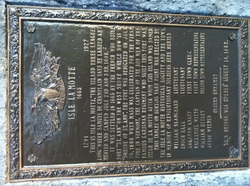During my daylong expedition to the Champlain Islands last June, I made a side detour to log an eBird survey in the town of Isle la Motte. I'm a history buff, so I had to explore Isle la Motte. Everything about Vermont began here. Samuel de Champlain landed here in 1609, and later the French established the first European settlement in Vermont in 1665. Champlain had 'discovered' the lake and named the mountains to the east the "Verts Monts", from which our state derives its name. The town claims that the small cannon outside the town's offices came from that original settlement.
Although I drove the entire length of the island, I chose its northernmost point as my survey location. Here, where the causeway meets the island, is the Burying Yard, which is both scenic and significant.
Checklist for Isle la Motte:
Great Blue Heron
Ring-billed Gull
Belted Kingfisher
Warbling Vireo
Black-capped Chickadee
Red-winged Blackbird
Song Sparrow
Although I drove the entire length of the island, I chose its northernmost point as my survey location. Here, where the causeway meets the island, is the Burying Yard, which is both scenic and significant.
Checklist for Isle la Motte:
Great Blue Heron
Ring-billed Gull
Belted Kingfisher
Warbling Vireo
Black-capped Chickadee
Red-winged Blackbird
Song Sparrow

This is Isle al Motte, "the island three leagues long" where Samuel de Champlain says he landed and hunted and camped, July 2nd and 3rd, 1609.
It was settled in 1665 by the French, who built Fort "St Ann" on the west shore, where now is a "Shrine of St Ann". The fort was dedicated on July 26, 1666 when mass was celebrated for the first time in Vermont. The captain of the 300 men of the famous Carignan Regiment who built this fort was Sieur de la Motte, after whom this island was named.
This tablet on Burying Yard Point was erected by the Isle la Motte Historical Society and the Town, in memory of Revolutionary soldiers buried here.
William Blanchard Lieutenant
Enoch Hall Lieutenant
Abraham Knapf First Town Clerk
Nathaniel Walls First Town Representative
William Uttley Second Town Representative
Jesse Welder
Others Unnamed
This bridge was opened August 14, 1882
It was settled in 1665 by the French, who built Fort "St Ann" on the west shore, where now is a "Shrine of St Ann". The fort was dedicated on July 26, 1666 when mass was celebrated for the first time in Vermont. The captain of the 300 men of the famous Carignan Regiment who built this fort was Sieur de la Motte, after whom this island was named.
This tablet on Burying Yard Point was erected by the Isle la Motte Historical Society and the Town, in memory of Revolutionary soldiers buried here.
William Blanchard Lieutenant
Enoch Hall Lieutenant
Abraham Knapf First Town Clerk
Nathaniel Walls First Town Representative
William Uttley Second Town Representative
Jesse Welder
Others Unnamed
This bridge was opened August 14, 1882
 RSS Feed
RSS Feed
